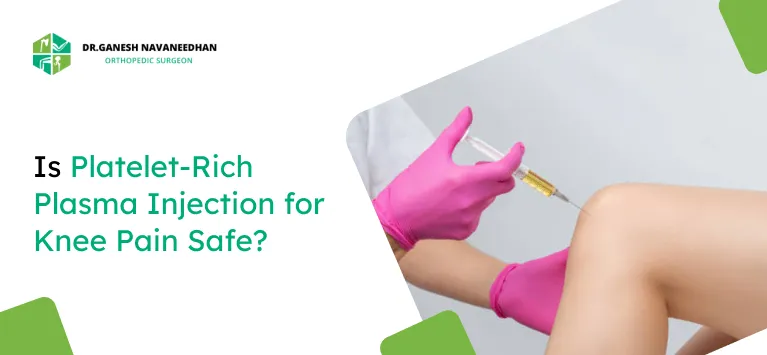- +91 62384 78716 +91 99475 78797
-
Sasthamangalam, Trivandrum
Sasthamangalam, Trivandrum

Knee pain is a common issue that affects millions of people worldwide, often caused by conditions like osteoarthritis, ligament injuries, or cartilage damage. These issues can significantly impact mobility and reduce the overall quality of life, making effective treatment essential. One emerging therapy gaining popularity is platelet rich plasma (PRP) injection for knees, a minimally invasive option that promotes natural healing.
In this blog, we will explore everything about PRP therapy for knee pain, including its procedure, plasma replacement therapy knee benefits, risks, and effectiveness.
PRP therapy for knees is a minimally invasive treatment that utilizes a patient’s blood to promote healing and tissue repair. The process involves drawing a small amount of blood, processing it in a centrifuge to separate and concentrate plasma-rich platelets, and injecting this solution, rich in growth factors, into the knee. This helps stimulate tissue repair, reduce inflammation, and manage chronic pain.
PRP for knees is particularly beneficial for conditions such as:
The plasma-rich protein injection for the knee delivers high concentrations of growth factors directly to the affected area. These growth factors encourage:
By targeting the root cause of the pain, PRP therapy aims to support the body’s natural healing process rather than just masking symptoms.
PRP therapy is a straightforward, three-step process designed to promote healing and reduce knee pain. Here’s what you can expect during the procedure:
Blood Collection: A small sample of blood is drawn from your arm.
Centrifugation: The blood is placed in a centrifuge, which spins it at high speeds to separate the components. This process isolates plasma rich in platelets, creating the PRP solution.
Injection: The PRP solution is injected directly into the affected knee joint. The doctor may use ultrasound guidance to ensure precision during the injection.
The entire procedure typically takes about 45 minutes to an hour. After the injection, you’ll be advised to rest briefly at the clinic. Although most patients can resume normal activities shortly afterward, it’s recommended to avoid strenuous activities for a few days.
Important Note: You may experience temporary pain or stiffness in the knee following the injection, so arranging for someone to drive you home is a good idea.
Natural Healing: PRP therapy harnesses your body’s natural resources to promote healing and tissue regeneration.
Minimally Invasive: As a non-surgical outpatient procedure, PRP therapy offers a shorter recovery time and reduced risk compared to surgery.
Faster Recovery: PRP promotes quicker recovery than surgical alternatives, making it a convenient treatment option.
Non-Surgical Alternative: PRP provides a safe and effective option for treating knee pain without the need for invasive procedures.
Reduced Medication Dependency: PRP injections may lower the need for opioids or anti-inflammatory medications.
Pain Relief and Reduced Stiffness: Many patients experience significant improvement in knee pain, stiffness, and inflammation.
Enhanced Mobility: PRP can improve knee joint function, allowing for better movement.
Research and patient testimonials suggest that PRP injections for knee pain are effective in managing conditions like osteoarthritis and chronic tendon injuries. According to studies, PRP therapy may delay the need for knee replacement surgery in some cases. While results can vary, most patients experience noticeable improvement within a few weeks.
Platelet rich plasma (PRP) injections for knee pain are generally considered safe, as the treatment uses the patient’s blood to promote healing. This natural approach minimizes the risk of adverse reactions compared to synthetic medications or surgical interventions.
PRP may not be suitable for individuals with:
Consult an orthopedic surgeon who can help determine if PRP for knee pain is appropriate for your condition. When performed by a trained specialist, PRP injections for knee pain offer a safe and effective option for managing knee-related conditions.
PRP is ideal for individuals who:
However, PRP may not be suitable for those with severe joint damage or certain medical conditions. A consultation with a healthcare professional is essential to determining eligibility.
Since PRP for knees uses your blood, the risk of adverse reactions is minimal. However, some individuals may experience:
These symptoms typically resolve quickly, and serious complications are rare when an experienced healthcare provider conducts the procedure.
The number of plasma injections for the knee varies depending on the severity of the condition. Most patients require 1-3 sessions spaced a few weeks apart. Maintenance injections may be recommended for long-term benefits.
PRP therapy is an innovative option for managing knee pain caused by conditions like osteoarthritis. By harnessing the body’s natural healing abilities, PRP for knee joints offers a promising alternative to more invasive treatments. If you’re considering plasma injected into the knee as a treatment option, consult with a qualified healthcare provider to determine if it’s right for you.
With growing evidence supporting its effectiveness, plasma-rich platelets for the knee are becoming a popular choice for those seeking natural, minimally invasive pain relief.
Copyright © 2025 Dr. Ganesh Navaneedhan. All Rights Reserved. | Designed By Harvee healthcare